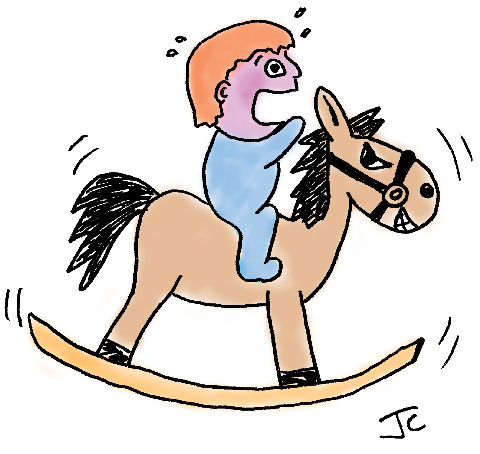While equine horses are acknowledged as potentially dangerous, another branch of the horse family — the non-equine horses — has quietly infiltrated modern society, and the dangers of their existence have been overlooked. When searching the South Australian Injury Surveillance and Control Unit database for presentations of horse-related injuries to a paediatric emergency department over a 5-year period,1 one of us (J A C) found a subgroup of data relating to injuries caused by horses of a non-equine nature. The data were initially discarded, but we faced growing concern that these horses may represent an unrecognised danger to society. After retrieving these data, we undertook an observational study in an attempt to fill a gap in published knowledge, and provide a discourse on five varieties of non-equine horse that may be responsible for occasional injury, distress and the odd foreign body.
The pommel horse is a large, slow-moving beast often found quietly grazing in the dusty storage areas of school auditoriums and community halls. It tends to be solitary in its habits and to live in its habitat for months without being disturbed. Periodically, it is herded to a position of prominence on the open floor by its handlers (known to the wider community as “PE teachers” or “gymnastic instructors”) and surrounded by padded matting. This is when pommel horses present the greatest danger to society. For reasons yet to be clarified, children and adults are drawn to jump onto its back and attempt feats of gymnastic daring.
The rocking horse is a common family pet, and many adults have fond memories of these playful beasts. However, horror film makers have recognised their occult potential and highlighted this in films such as The rocking horse winner (1949, and remade several times since). Rocking horses are highly excitable and most injuries tend to be sustained during riding when the rocking horse suddenly breaks into a gallop. There appears to be an association between injury and the presence of an older child, especially an older brother, whose behaviour may incite the rocking horse to greater activity. Unfortunately, rocking horses possess a hard mane and the impact of a child’s face on the mane is often the cause of tears and injuries.
In contrast to their solitary domesticated cousins, playground horses are often found in small herds in parks. This breed is far more volatile than the rocking horse and has been known to leap into vigorous motion, often expelling or bucking off its rider, leading to injury. Similar to the rocking horse, the playground horse possesses a hard mane and hide, and contact injuries to children’s heads are common. Trampling injuries, on the other hand, are uncommon as these beasts are generally tethered firmly to the ground. Ten children presented to the emergency department during the study period following interactions with these animals, and their injuries were equally split between contact trauma and falls.
Throughout the mid to late 20th century, plastic horse heads were frequently found in the domestic environment, often living peacefully alongside plastic horse bodies and cowboy parts in bedrooms, behind couches and wedged into car seats. However, with the advent of virtual and computerised entertainments, their numbers have significantly declined. During the study period, only one child presented with injury due to this endangered species. However, it was later learned that the horse head had been adopted by the child and kept as a pet in the left nostril. Unfortunately for the child, its hard shiny skin produced a foreign-body reaction and the creature had to be removed. It was reintroduced to the wild by the hospital garbage disposal contractors.
Often confused with laryngitis and other croup-like illnesses, the horse voice is a largely benign condition that usually spontaneously resolves over time. It occasionally deteriorates into donkey-like braying, but the mane problem is temporary interference with regular communication activities. Fortunately, only one child was triaged with this condition, and the triage nurse has since undertaken remedial spelling therapy.
Like the equine variety, non-equine horses can be fun and exciting to ride. However, the hidden dangers should not be disregarded, as encountering these beasts often leads to injury. In this article, we have gone some way to alerting medical practitioners of these perils, but we stop short at recommending the wearing of protective gear by at-risk children. Considering that the upkeep of non-equine horses is considerably cheaper than that of their living namesakes, the benefits of their presence in homes and playgrounds may easily outweigh the risks.






Abstract
A search for the term “horse” in the database of the South Australian Injury Surveillance and Control Unit was performed for presentations of horse-related injuries to a paediatric emergency department of an Australian tertiary teaching hospital over a 5-year period.
After all equine-related episodes were extracted, the remaining presentations were herded together and conclusions were jumped to.
When legitimate science and research technique failed, poetic licence was prevailed upon.